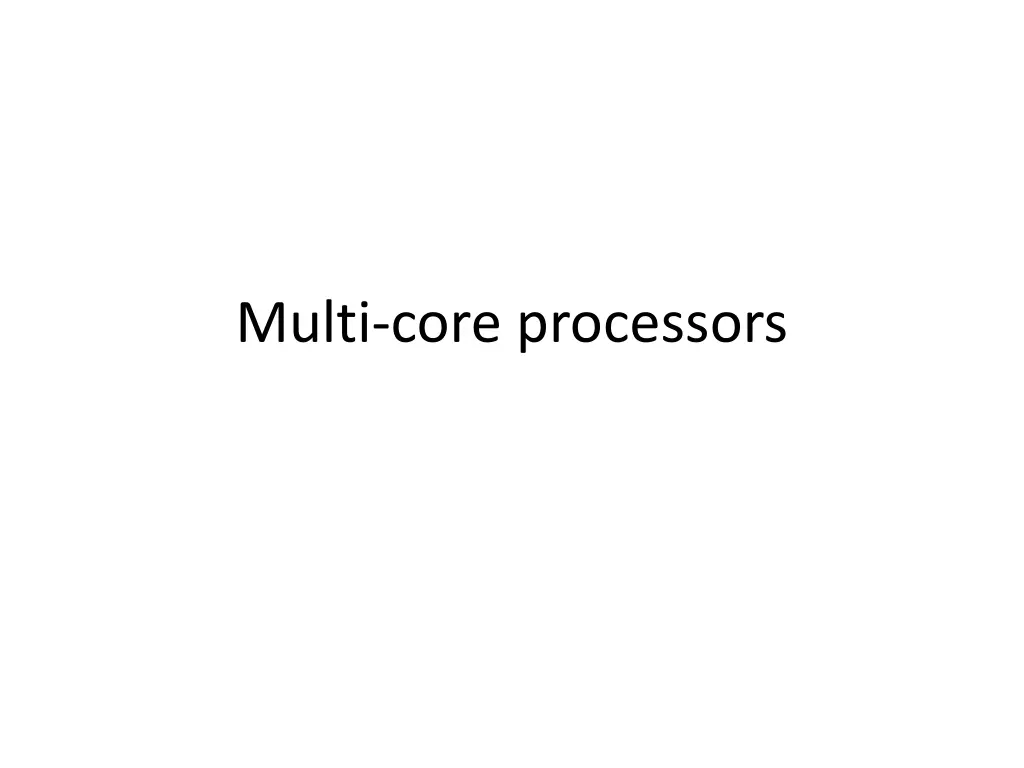
Evolution of Multi-core Processors and its Benefits
Explore the development and advantages of multi-core processors, including reasons for their adoption, challenges faced by single-core systems, and how multi-core architectures enhance performance and efficiency. Discover how operating systems interact with multi-core setups and the role of instruction-level parallelism in modern computing.
Download Presentation

Please find below an Image/Link to download the presentation.
The content on the website is provided AS IS for your information and personal use only. It may not be sold, licensed, or shared on other websites without obtaining consent from the author. If you encounter any issues during the download, it is possible that the publisher has removed the file from their server.
You are allowed to download the files provided on this website for personal or commercial use, subject to the condition that they are used lawfully. All files are the property of their respective owners.
The content on the website is provided AS IS for your information and personal use only. It may not be sold, licensed, or shared on other websites without obtaining consent from the author.
E N D
Presentation Transcript
Processor development till 2004 Out-of-order Instruction scheduling 2
Why multi-core ? Difficult to increase clock frequencies even higher heat problems. Moore s law is at its limits Deeply pipelined circuits: heat problems, needs special cooling arrangements Many new applications are multithreaded Multi-core is an attractive alternative. General trend in computer architecture (shift towards more parallelism) 3
Single-core CPU chip the single core 5
Multi-core architectures Replicate multiple processor cores on a single die. Core 1 Core 2 Core 3 Core 4 Multi-core CPU chip 6
Multi-core CPU chip The cores fit on a single processor socket Also called CMP (Chip Multi-Processor) c o r e c o r e c o r e c o r e 1 2 3 4 8
The cores run in parallel thread 1 thread 2 thread 3 thread 4 c o r e c o r e c o r e c o r e 1 2 3 4 9
Within each core, threads are time-sliced (just like on a uniprocessor) several threads several threads several threads several threads c o r e c o r e c o r e c o r e 1 2 3 4 10
Interaction with the Operating System OS perceives each core as a separate processor OS scheduler maps threads/processes to different cores Most major OS support multi-core today: Windows, Linux, Mac OS X, 11
Instruction-level parallelism Parallelism at the machine-instruction level Instruction-level parallelism enabled rapid increases in processor speeds over the last 15 years The processor can re-order, pipeline instructions, split them into microinstructions, do aggressive branch prediction, etc. 12
Thread-level parallelism (TLP) This is parallelism on a more coarser scale Server can serve each client in a separate thread (Web server, database server) A computer game can do AI, graphics, and a physics- related computation in three separate threads Single-core superscalar processors cannot fully exploit TLP Multi-core architectures are a natural evolution: explicitly exploiting TLP 13
General context: Multiprocessors Multiprocessor is any computer with several processors SIMD Single instruction, multiple data Modern graphics cards MIMD Multiple instructions, multiple data 14
Multiprocessor memory types Shared memory: In this model, there is one (large) common shared memory for all processors Distributed memory: In this model, each processor has its own (small) local memory, and its content is not replicated anywhere else 15
Multi-core processor is a special kind of a multiprocessor: All processors are on the same chip Multi-core processors are MIMD: Different cores execute different threads (Multiple Instructions), operating on different parts of memory (Multiple Data). Multi-core is a shared memory multiprocessor: All cores share the same memory 16
What programs can use multicore Editing a photo while recording a TV show through a digital video recorder Downloading software while running an anti- virus program Anything that can be threaded today will map efficiently to multi-core BUT: some applications difficult to parallelize 17
Intel Core Architecture These are multi-core processors Intel i3 mostly dual core Intel i5 and i7 (Nehalem) are quad core processors Intel i7 has L1 cache 32KB instructions + 32 KB data per core + L2 256 KB per core + L3 cache 4-8 MB shared among all cores 18
